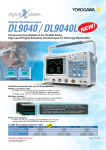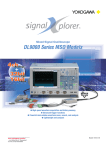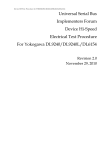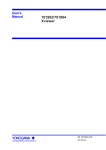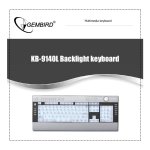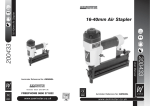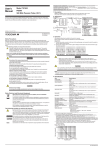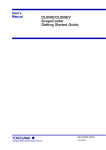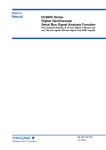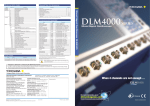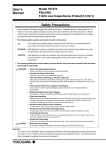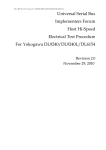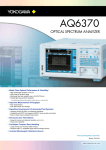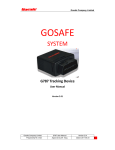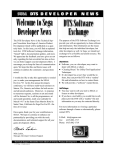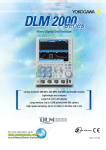Download Main Specifications
Transcript
Optional Accessories PBA2500 2.5 GHz active probe Main Specifications PBD2000 2.0 GHz differential probe This active probe can be used in combination with the DL9000 series to measure signals with an analog bandwidth up to 1.5 GHz. This differential probe is suited for observation of fast differential signals, such as LVDS. Using this probe in combination with the DL9000 series, you can observe differential signals with an analog bandwidth up to 1.5 GHz. Bandwidth: DC to 2.5 GHz (-3 dB) Attenuation and DC accuracy: 10:1 (±2%) Input resistance: 100 kΩ (±2%) Input capacitance: Approx. 0.9 pF (typ.) Dynamic range: ±7 V Bandwidth: DC to 2.0 GHz (-3 dB) Attenuation and DC accuracy: 10:1 (50 Ω) Input capacitance: Approx. 1.1 pF (typ.) Max. differential input voltage: ±5 V Models Model name (No.) DL9040 (701307) DL9040L (701308) DL9140 (701310) DL9140L (701311) DL9240 (701312) DL9240L (701313) 500 MHz passive probe PBL5000 5 GHz low capacitance probe 10 MΩ ±2% (when used with the DL9000) Input capacitance: Approx. 14 pF (typ.) (when used with the DL9000) Attenuation: Fixed to 1/10 Bandwidth: DC to 500 MHz (within -3 dB) Max. Input voltage: ±600 V DC + AC peak Input resistance: 701920 This wideband low capacitance probe can be used with the 50 ohm input setting. Connector type: SMA Input resistance: 450 Ω or 950 Ω Input capacitance: Approx. 0.25 pF (typ. 450 Ω), 0.4 pF (typ. 950 Ω) Attenuation: 10:1 or 20:1 Bandwidth: DC to 5 GHz (-3 dB) Max. input voltage: 20 Vrms, 40 V ACpeak ±12 V/500 MHz differential probe 701975 Bandwidth: DC to 500 MHz (within -3 dB) Attenuation: 1/10 (fixed) Input impedance (typ.): 100 kΩ/2.5 pF Max. allowable differential voltage: ±12 V (DC + ACpeak) Max. common mode input voltage: ±30 V (DC + ACpeak) (Output impedance: 50 Ω) 701921 ±700 V/100 MHz differential probe 50 ohm DC block This DC block is used to remove bias voltage occurring when the PBL5000 probe is used. Overall length: Approx. 25 mm Connector type: SMA Input impedance: 50 Ω Frequency range: 20 MHz to 6 GHz Max. input voltage: ±10 V (DC + ACpeak) 701932 Bandwidth: DC to 100 MHz (-3 dB) Attenuation: 1/10 or 1/100 (selectable) Max. allowable differential voltage: ±700 V (DC + ACpeak) Max. common mode input voltage: ±700 V (DC + ACpeak) (common to both 1/10 and 1/100 attenuation ratios) DC to 100 MHz 30 Arms current probe Bandwidth: DC to 100 MHz (-3 dB) Max. continuous input range: 30 Arms Amplitude accuracy: 0 to 30 Arms: ±1% of rdg ±1 mV Up to 50 Apeak: ±2.0% of rdg (DC, 45 to 66 Hz) Weight: Approx. 240 g Freq. BW 500 MHz 500 MHz 1 GHz 1 GHz 1.5 GHz 1.5 GHz Max. record length 2.5 MW 6.25 MW 2.5 MW 6.25 MW 2.5 MW 6.25 MW Basic Specifications Input channels: Input coupling: Input impedance: Voltage axis sensitivity: PB500 Max. sampling rate 5 GS/s 5 GS/s 5 GS/s 5 GS/s 10 GS/s 10 GS/s Maximum input voltage: DC offset max. setting range: (When probe attenuation set to 1:1) 4 (CH1 to CH4) AC, DC, GND, DC50Ω 1 MΩ ±1.0% approx. 20 pF (when using PB500 probe, 10 MΩ ±2.0%, approx. 14 pF) 50 Ω ±1.5% For 1 MΩ input : 2 mV/div to 5 V/div (steps of 1-2-5) ranges For 50 Ω input : 2 mV/div to 500 mV/div (steps of 1-2-5) For 1 MΩ input : 150 Vrms CAT I For 50 Ω input : 5 Vrms or less and 10 Vpeak or less For 1 MΩ input 2 mV/div to 50 mV/div : ±1 V 100 mV/div to 500 mV/div : ±10 V 1 V/div to 5 V/div : ±100 V For 50 Ω input 2 mV/div to 50 mV/div : ±1 V 100 mV/div to 500 mV/div : ±5 V Vertical (voltage) axis sensitivity: For 1 MΩ input : ±(1.5% of 8 div + offset voltage accuracy) DC accuracy1: For 50 Ω input : ±(1.5% of 8 div + offset voltage accuracy) Offset voltage axis accuracy1: 2 mV/div to 50 mV/div : ±(1% of setting + 0.2 mV) 100 mV/div to 500 mV/div : ±(1% of setting + 2 mV) 1 V/div to 5 V/div : ±(1% of setting + 20 mV) Voltage standing-wave ratio (VSWR): 1.5 or less within frequency bandwidth (typical value4) Frequency characteristics1, 2 (Attenuation point of -3 dB when inputting a sinewave of amplitude ±2 div or equivalent) DL9040/9040L DL9140/DL9140L DL9240/DL9240L For 50 Ω input 0.5 V/div to 10 mV/div: DC to 500 MHz DC to 1 GHz DC to 1.5 GHz 5 mV/div: DC to 400 MHz DC to 750 MHz DC to 1 GHz 2 mV/div: DC to 400 MHz DC to 600 MHz DC to 750 MHz For 1 MΩ input (from the probe tip when using the PB500 dedicated passive probe) 5 V/div to 10 mV/div: DC to 500 MHz DC to 500 MHz DC to 500 MHz 5 mV/div to 2 mV/div: DC to 400 MHz DC to 400 MHz DC to 400 MHz 3 Residual noise level : 0.4 mV rms or 0.05 div rms, whichever is larger (typical value4) A/D conversion resolution: 8-bit (25 LSB/div) Bandwidth limit: For each channel, select from FULL, 200 MHz, 20 MHz, 8 MHz, 4 MHz, 2 MHz, 1 MHz, 500 kHz, 250 kHz, 125 kHz, 62.5 kHz, 32 kHz, 16 kHz, and 8 kHz (separately configurable on each of channels CH1 to CH4); Limit implemented with analog (200 MHz, 20 MHz) and digital filters (IIR+ FIR). Max. sampling rate: DL9040/9040L/9140/9140L DL9240/9240L Real time sampling mode: Interleave mode ON: 5 GS/s 10 GS/s Interleave mode OFF: 2.5 GS/s 5 GS/s Repetitive sampling mode: 2.5 TS/s 2.5 TS/s Maximum record length DL9040/9140/9240 DL9040L/DL9140L/DL9240L 2.5 MW 6.25 MW Time axis setting range: 500 ps/div to 50 s/div (steps of 1-2-5) 1 Time base accuracy : ±0.001% Time axis measurement accuracy1: ± (0.01% + 10 ps + 1 sample interval) 5 Max. acquisition rate : When using 1.25 MW, 60 waveforms/sec/ch When using 12.5 kW, 9000 waveforms/sec/ch When using 2.5 kW, 25000 waveforms/sec/ch 5 Min. dead time (N single) : 400 ns or less (equivalent to 2.5 M waveforms/sec) Trigger Section 701922 ±20 V/200 MHz differential probe Bandwidth: DC to 200 MHz (-3 dB) Attenuation: 1/10 (fixed) Max. allowable differential voltage: ±20 V (DC + ACpeak) Max. common mode input voltage: ±60 V (DC + ACpeak) Output impedance: 50 Ω 8 701931 DC to 20 MHz 500 Arms current probe Bandwidth: DC to 2 MHz (-3 dB) Max. continuous input range: 500 Arms Amplitude accuracy: 0 to 500 Arms: ±1% of rdg ±5 mV Up to 700 Apeak: ±2.0% of rdg (DC, 45 to 66 Hz) Weight: Approx. 520 g Trigger modes: Trigger source: CH1 to CH4: LINE: EXT: Trigger level range: CH1 to CH4: EXT: Trigger level setting resolution: CH1 to CH4: EXT: Window comparator: Center: Width: Auto, Auto Level, Normal, Single, and N Single Signals applied to measurement input terminals Connected commercial power signal (only available with Edge trigger) Signal input from EXT TRIG IN terminal ±4 divisions from the screen center ±2 V (1:1), ±20 V (10:1 when used with a probe) 0.01 div 5 mV (1:1), 50 mV (10:1 when used with a probe) Separately configurable on each of channels CH1 to CH4 ±4 divisions from the screen center ±4 divisions from Center Trigger level accuracy CH1 to CH41: EXT1: Trigger sensitivity: ±(0.2 div + 10% of trigger level) ±(50 mV + 10% of trigger level) DL9040/DL9040L DL9140/DL9140L DL9240/DL9240L CH1 to CH41 1 divp-p DC to 500 MHz DC to 1 GHz DC to 1 GHz 1 100 mVp-p DC to 100 MHz DC to 100 MHz DC to 100 MHz EXT where Edge OR1 1 divp-p DC to 50 MHz DC to 50 MHz DC to 50 MHz Trigger types: Edge/State Edge: Trigger occurs on the edge of a single trigger source. Edge (Qualified): Trigger occurs on the edge of a single trigger source when Qualification condition is true. Edge OR: Trigger occurs on the OR logic of the edge conditions set to multiple trigger sources. State: Trigger occurs on ENTER/EXIT when the state condition is true. Width Pulse: Trigger occurs on a width of a single trigger source. Pulse (Qualified): Trigger occurs on a width of a single trigger source when Qualification condition is true. Pulse State: Trigger occurs on a width when the state condition is true. Time width setting mode: More than: Trigger occurs upon change in condition when the condition remains true longer than time T1. Less than: Trigger occurs upon change in condition when the condition remains true shorter than time T1. Between: Trigger occurs upon change in condition when the condition remains true longer than time T1 and shorter than time T2. Out of Range: Trigger occurs upon change in condition when the condition remains true shorter than time T1 and longer than time T2. Time out: Trigger occurs when the condition is true for duration longer than time T1. Specified time (T1/T2): 1 ns to 10 s, 500 ps resolution Time accuracy: ±(0.2% of setting + 1 ns) Event Interval Event Cycle: Trigger occurs when the event cycle is within the specified time range. Event Delay: After Event 1 occurs, trigger occurs on 1st occurrence of Event 2 that satisfies the timing constraints. The trigger process is reset if Event 1 or Event 2 occurs before the timing constraints are satisfied. Event Sequence: After Event 1 occurs, trigger occurs on 1st occurrence of Event 2 that satisfies the timing constraints. The trigger process is reset if Event 1 occurs before the timing constraints are satisfied. Time width setting mode: Function identical to the time width setting mode for Width Specified time (T1/T2): 1.5 ns to 10 s, 500 ps resolution Time accuracy: ±(0.2% of setting + 1 ns) Event types: Events can be selected from Edge, Edge Qualified, State, Pulse, Pulse Qualified, Pulse State, I2C, CAN, SPI, and Serial trigger types. Enhanced: TV: Trigger occurs on video signals of various broadcasting system formats Mode: NTSC, PAL, HDTV, USER Input CH: CH1-CH4 Sync Guard: Hsync 60 to 90% (increments of 1%) Line: 5-1054 (NTSC), 2-1251 (PAL), 2-1251 (HDTV), 2-2048 (USER) Field: 1/2/X Frame Skip: 1/2/4/8 2 I C: Triggers on I2C bus signals Mode: NON ACK, Every Start, General Call, (Start byte/HS Mode), ADR&DATA SPI: Triggers on SPI (serial peripheral interface) bus signals Mode: 3 wire, 4 wire CAN: Bit rate: 1 Mbps, 500 kbps, 250 kbps, 125 kbps, 83.3 kbps User (freely settable in 100 bps increments) Input channel: CH1 to CH4: Input through differential probe Mode: SOF, Frame ID, Data field, Remote Frame, Error Frame, Ack etc. Serial pattern: Triggers on general-purpose serial communication signals. Max. bit rate: 50 Mbps Max. bit length: 128 bits Display Display: Display screen size: Total number of pixels: Waveform display resolution: 8.4-inch (21.3 cm) color TFT liquid crystal display 170.5 mm (width) 127.9 mm (height) 1024 768 (XGA) 800 640 9 Main Specifications Param: GO/NOGO telecom test: Functions Waveform Acquisition/Display Functions: Acquisition modes: Selectable from three acquisition modes – Normal, Average and Envelope High resolution mode: Vertical resolution is increased to max. 13 bits. Repetitive sampling mode: Allows switching between realtime and repetitive sampling in certain time axis settings. Interpolate function: Interpolates actual sampled data by up to 1000 times (or up to 2000 times in High-Res. mode) and increases the time resolution (up to 2.5 TS/s) Roll mode: Roll-mode display is enabled during the following time axis range when the trigger mode is Auto, Auto Level or Single: 100 ms/div to 50 s/div Record length: DL9040L/9140L/9240L: 2.5 kW, 62.5 kW, 12.5 kW, 25 kW, 62.5 kW, 125 kW, 250 kW, 625 kW, 1.25 MW, 2.5 MW, 6.25 MW DL9040/9140/9240: 2.5 kW, 62.5 kW, 12.5 kW, 25 kW, 62.5 kW, 125 kW, 250 kW, 625 kW, 1.25 MW, 2.5 MW Accumulation: Accumulates waveforms on the display. Choose Count/ Time and Inten/Color. Snapshot: Retains the current displayed waveform on the screen. Analysis Functions Search and Zoom function: Voltage axis zoom factor: Time axis zoom factor: Auto scroll function: Search function: Search types: History memory: Max data: 10 Zooms the displayed waveform along the time (Horizontal Zoom) and voltage (Vertical Zoom) axes. Independent zooming factors can be applied to two zoom areas. 1 to 10 times 1 time to 1data/div Automatically scrolls the zoom window along the time axis Searches the currently displayed waveform for a specified portion occurring beyond a specified time, and displays the zoomed result on the screen. Edge, Edge Qualified, State, Pulse, Pulse Qualified, Pulse, State, Serial Pattern, I2C (optional), SPI (optional) DL9040L/9140L/9240L: 2000 (2.5 kW), when using history 1600 (2.5 kW), when in N single mode DL9040/9140/9240: 1000 (2.5 kW), when using history 800 (2.5 kW), When in N single mode History search: Searches for and displays waveforms from the history memory that meet specified conditions. Search types: Rect, WAVE, Polygon, Parameter (Measure/FFT/XY) Replay: Automatically replays history waveforms. Display: Selected acquisition (#) or Average (Avg) Cursor measurements: The following five cursors can be selected: Vertical, Horizontal, VT, Marker, Serial Automatic measurement of waveform parameters: Performs automated measurement of the following waveform parameters. Items unrelated to cycle which will be derived out of all data in the range. MAX, MIN, HIGH, LOW, P-P, HIGH-LOW, +OVER, -OVER, RMS, MEAN, Sdev, IntegTY Items related to cycle which will be derived out of all data in the range. C.rms, C.mean, C.Sdev, C.IntegTY, (1/FREQ), FREQ, COUNT, BURST Items which will be derived from the first encounter from the beginning of the specified range. +WIDTH, -WIDTH, PERIOD, DUTY, RISE, FALL, DELAY Telecom test: Performs mask test and eye pattern measurement Mask test items: Wave Count, Wave Count%, Sample Point Count, Sample Point Count% Eye pattern items: Vtop, Vbase, stop, sbase, Tcrossing1, Tcrossing2, Vcrossing, Crossing%, Eye Height, Eye Width, Q Factor, Jitter, Duty Cycle Distortion%, Ext Rate dB, Rise, Fall Computation functions: Computes up to eight traces (CH1-CH4/M1-M4) +, -/*, INTEG, COUNT (EDGE), COUNT (ROTARY), Through, Delay, Moving Avg, LowPass, High Pass, Stuff Bit (CAN option) Reference functions: Display and analysis (computation and cursors) of up to four traces (M1-M4) of the saved waveform data. Waveforms including history can also be loaded for history searches or replay. Various parameters can be changed (however waveforms are not affected by T/Div changes). Action-on-trigger: Automatically measured waveform parameters and waveform zones are determined, and the selected action is carried out each time conditions are met. Modes: OFF, All Condition, (GO/NOGO Zone/Param), GO/NOGO Telecom Test) Actions: Buzzer, Print, Save, Mail All conditions: After EXEC is pressed, the specified action is performed upon each acquisition GO/NOGO zone: Determines whether or not the acquired waveform passes through the specified area Zone types: RECT, Polygon, WAVE GO/NOGO parameter: Determines whether or not the specified parameter of the acquired waveform is within the specified range ANALYSIS: X-Y: FFT: Wave parameter: Accum histogram: Serial bus: Choose Measure, FFT, or XY Performs judgment using the conditions specified in the telecom test. Selectable from XY, FFT, Wave Parameter, Accum Histogram and Serial Bus displays XY1, XY2 and T-Y simultaneously supports up to 250 k points FFT Single wave parameters can be viewed in one of the following formats. (Histogram, Trend and List) A histogram of the selected area can be displayed for a continuous signal. I2C, SPI and CAN buses can be analyzed and the analysis results displayed (optional). I2C Bus Analysis Functions (optional) •Applicable bus: •Trigger function (standard): I2C bus: Bus speed : Max. 3.4 Mbit/s Address mode : 7 bit/10 bit SM bus: complies with System Management bus Source : SCL : CH1 to CH4 : SDA : CH1 to CH4 Selectable from the following five options: trigger on combination of assigned address & data pattern trigger on non acknowledge condition trigger on start condition trigger on general call and the following byte trigger on Start byte and HS mode Type: - Address & data: - Non-Ack: - Every start: - General call: - Start byte / HS mode: •Analysis function: Signal input: CH1 to CH4, M1 to M4 can be configured Detailed data display mode: Time from the reference point, data (simultaneous binary and hex representations), presence/absence of ACK, R/ W, address or data, start condition Simple display mode: Data (hex representation), R/W, start condition, presence/ absence of ACK, address or data Analyzable number of data items: 40,000 bytes max. •Search function: Pattern search: Searches data that agrees with the preset address pattern, data pattern and acknowledge bit condition. •Analysis result save function: Storage of analysis list data: The data can be saved to CSV-format files. Frame ID. Data OR trigger, (Specify up to four ID, Data or Ack trigger conditions to set triggers on a logical OR condition.) Event Interval trigger •Analysis function: Analyzable number of frames: 3,000 max. Analysis result display: Waveform and analysis list display Detailed analysis list display (Analysis display items: Frame type, time from trigger point, frame ID, DLC, Data, CRC, presence/absence of ACK) •Analysis support functions: Data search Field jump Stuff bit calculation •Analysis result save function: Storage of analysis list data: The data can be saved to CSV-format files. Built-in Printer (/B5 Option) Printing method Paper width Effective print width Thermal line-dot 112 mm 104 mm (832 dots) Auxiliary I/O Section Rear panel I/O signal: Ext. trigger input, ext. trigger output, trigger comparator output, GO/NO-GO I/O, video output Probe interface terminal (front panel) No. of terminals: 4 Supported probes: PBA2500, PBD2000, PB500 Probe power terminal (/P2 option, rear panel): No. of terminals: 2 Supported probes: FET probe (700939), current probes (701930, 701931, 701932, 701933), and differential probes (701920, 701921, 701922) Storage Internal storage media: Capacity: Usage: 90 MB (Flash ROM) Saving and loading of waveforms and panel settings SPI Bus Analysis Functions (optional) Internal Hard Drive (/C8 Option) •Trigger function: Mode: Bit order: Source: Capacity/file system: File name: 3 wire/4 wire MSB/LSB Clock signal (SCK) Data 1 (MOSI) Data 2 (MISO) CS signal (SS) CH1 to CH4 CH1 to CH4 CH1 to CH4 CH1 to CH4 •Analysis function: Analyzable number of data items: 40,000 bytes max. Display of analysis results: Analysis results can be displayed using the following 2 methods - Simple analysis result list: Data (hex representation), CS signal status - Detailed analysis result display: Detailed analysis result list, time from the reference point, data (select and show either Binary or Hex data), and CS signal status can be displayed. •Search function: - Pattern search: Waveforms can be searched by specifying data pattern. When a waveform that agrees with the pattern is found, the zoom box moves to the position of that waveform to show the specified waveform. •Analysis result save function: Storage of analysis list data: The data can be saved to CSV-format files. 40 GB FAT32 Supports long file names of up to 256 ASCII characters USB Peripheral Connection Ports Connector: USB-type A connector 2 Supported transmission standards: LS (Low Speed) mode (1.5 Mbps), FS (Full Speed) mode (12 Mbps) Supported devices: USB HID Class Ver1.1-compliant mouse/109 keyboard USB Printer Class Ver.1.0-compliant printers EPSON: Ink Jet Printers HP: PCL Ink Jet Printers USB Mass Storage Class Ver.1.1-compliant mass storage device USB hub device (1 unit only) USB-PC Connection Ports Connector: USB-type B connector 1 Supported transmission standards: HS (High Speed) mode, FS (Full Speed) mode Supported class: Operates as a multifunctional device simultaneously supporting the following two protocols: USBTMC-USB488 (USB Test and Measurement Class Ver.1.0) A USB bus can be employed to use GPIB commands. Mass Storage Class Ver.1.1 The DL9000's internal storage media, hard disk, PC card, and USB mass storage device can be accessed (read/ write) from a PC (formatting is not supported). Ethernet Communication (/C10 and /C8 Options) Connector type: Transmission method: Supported services: RJ-45 connector 1 Ethernet (100BASE-TX/10BASE-T) DHCP, DNS, Microsoft network file sharing server & client, FTP server, SNTP client, SMTP client, Firewall functions (network printers will be supported in the near future) General Specifications Rated supply voltage: 100 to 120 V AC/200 to 240 V AC (automatically selected) Allowable supply voltage fluctuation range: 90 to 132 V AC/180 to 264 V AC Rated supply frequency: 50/60 Hz Allowable power supply frequency variation:48 to 63 Hz Maximum power consumption: 300 VA Withstanding voltage (between power supply and case): 1.5 kV AC for one minute. External dimensions: 350 (W) 200 (H) 178 (D) mm (when printer cover is closed; excluding handle and protrusions) Weight: Approx. 6.5 kg (including printer) Battery backup: Setup data and clock are backed up by an internal lithium battery Battery life: Approximately 5 years (at an ambient temperature of 25°C) Operating temperature range: 5–40°C 1. Measured value under standard operating conditions after a 30-minute warm-up followed by calibration. Standard operating conditions: Ambient temperature: 23 ±5°C Ambient humidity: 55 ±10% Error in supply voltage and frequency: Within 1% of rating 2. Value in the case of a repetitive signal The frequency bandwidth of a single-shot phenomenon is the smaller of the two values, DC to sampling frequency/2.5 or the frequency bandwidth of the repetitive phenomenon. 3. When the input section is shorted, the acquisition mode is set to normal, the interleave mode is OFF, accumulation is OFF, and the probe attenuation is set to 1:1. 4. Typical value denotes a representative or average value and is not strictly guaranteed. 5. The parallel acquisition architecture of the DL9000 series ensures no decrease in acquisition rate for multichannel use. External Dimensions (Common to All Models) Unit: mm * Please contact your local Yokogawa sales office for model names of verified devices Max. No. of devices: 4 PC Card Interfaces Number of slots: Supported cards: 2 (front panel (1), rear panel (1)) GPIB card (National Instruments NI PCMCIA-GPIB card), Flash ATA memory card (PC card TYPE II), CF card + adapter card, and various hard disk type PC cards * Please contact your local Yokogawa sales office for model names of verified devices CAN Bus Analysis Functions (optional) •Applicable bus: •Bit rate: •Trigger function (standard): Source: Type: CAN version 2.0 A/B High-speed CAN (ISO11898) Low-speed CAN (ISO11519-2) 1 Mbps, 500 kbps, 500 kbps, 250 kbps, 125 kbps, 83.3 kbps, user-defined CH1 to CH4, Input through differential probe SOF trigger Frame ID trigger Data field trigger: Selectable up to 8 bytes Remote Frame trigger Error Frame trigger Ack trigger For detailed specifications, visit our homepage at http://www.yokogawa.com/tm/DL9000 11 Power Supply Analysis and User-Defined Math Function Specifications • Power supply analysis function (/G4 option) Propagation time difference correction (deskew): The difference in propagation time of voltage and current probe signals can be automatically or manually corrected. Correction range is ±80 ns (0.01 ns resolution) Automated measurement of power supply analysis parameters: Power supply analysis parameters can be measured automatically and simultaneously with standard measurement items (waveform parameters) Voltage channels: Umn, Urmn, S, P, Q, Z, λ, Wp, Wp+, Wp-, Abs.Wp, UP-P(P-P), U+pk(Max), U-pk(Min), Udc(C.Mean), Urms(C.Rms), Uac(C.Sdev) Current channels: Imn, Irmn, q, q+, q-, Abs.q, I2t, IP-P(P-P), I+pk(Max), I-pk(Min), Idc(C.Mean), Irms(C.Rms), Iac(C.Sdev) Automated measurement of two areas is also possible Statistical processing of measured values: Enables computation of statistics (Min, Max, Ave, σ) from measured values of power supply analysis items Waveform computation of power supply analysis parameters: Active power, impedance, Joule-integral, and FFT waveform computation can be performed simultaneously with standard waveform computations. Harmonic analysis: Allows for easy comparison with limit values per harmonic current emission standard IEC 61000-3-2 edition 2.2 and EN61000-3-2 (2000) Trend display: Changes over time of waveform parameter values measured every cycle can be displayed as trends (in a list and graph). History search: History search can be performed using power supply analysis parameters in the same manner as standard measurement parameters GO/NO-GO judgment: GO/NO-GO judgments can be made using power supply analysis parameters as well as standard measurement parameters Saving harmonic analysis results: Results of harmonic analysis can be saved to CSV files • User-defined math (/G2) The following operators can be arbitrarily combined in equations: +, -, ×, /, ABS, SQRT, LOG, EXP, LN, SIN, COS, TAN, ASIN, ACOS, ATAN, INTEG, DIFF, BIN, DELAY, P2 (value squared) CAN & LIN Bus Analysis Function Specifications Applicable bus: CAN version 2.0A/B (ISO11898, ISO11519-2) LIN rev. 1.3, 2.0 Bitrate: CAN: 1 Mbps/500 kbps/250 kbps//125 kbps/83.3 kbps/33 kbps User (can be set arbitrarily at 100 bps resolution ) LIN: 19.2 kbps/9.6 kbps/4.8 kbps/2.4 kbps/1.2 kbps/ User (can be set arbitrarily at 10 bps resolution ) • Trigger functions (come standard) Trigger source: CH1-CH4: (CAN input via differential probe ) Trigger types (CAN): SOF, frame ID, data field (can be specified with up to 8 bytes), remote frame, error frame, Ack, frame ID/data OR, (up to four ID, data, and Ack trigger conditions can be specified in an OR relationship) Trigger type (LIN): Synch break CAN/LIN triggers: Event interval • Analysis functions No. of analyzable frames: 3,000 max. Analysis results display: Waveform and analysis list display, detailed analysis list display, decode display CAN analysis, display items: Frame type, time from trigger point, frame ID, DLC, data, CRC, presence/absence of Ack LIN analysis, display items: ID, ID-field, data, checksum, information • Auxiliary analysis functions Data search functions Search conditions (CAN): Top of frame, ID, data, remote frame, error frame Search conditions (LIN): Synch field, ID, data field jump function (CAN) Stuff bit computation function (CAN) • Analysis results saving function Detailed analysis list: Can be saved to file in CSV format Model and Suffix Codes of DL9010/9010/9240 Suffix Code Model Description 701307 DL9040 digital oscilloscope 500 MHz max. 5 GS/s (2.5 GS/s/ch), 2.5 Mword/ch 701308 DL9040L digital oscilloscope 500 MHz max. 5 GS/s (2.5 GS/s/ch), 6.25 Mword/ch 701310 DL9140 digital oscilloscope 1 GHz max. 5 GS/s (2.5 GS/s/ch), 2.5 Mword/ch 701311 DL9140L digital oscilloscope 1 GHz max. 5 GS/s (2.5 GS/s/ch), 6.25 Mword/ch 701312 DL9240 digital oscilloscope 1.5 GHz max. 10 GS/s (5 GS/s/ch), 2.5 Mword/ch 701313 DL9240L digital oscilloscope 1.5 GHz max. 10 GS/s (5 GS/s/ch), 6.25 Mword/ch Power cable -D UL/CSA standard -F VDE standard -Q BS standard -R AS standard -H GB standard Help menu language -HE English Help -HC Chinese Help -HK Korean Help Options /B5 Built-in printer /P2¹ Probe power connections on rear panel (2 outputs for 900 MHz FET probe and current probe) /C8² Built-in hard disk + Ethernet interface /C10² Ethernet interface /G2² User-defined math /G4² Power supply analysis function (includes user-defined math function) /F5³ I²C + SPI bus analysis function /F7³ CAN + LIN + SPI bus analysis function /F8³ I²C + CAN + LIN + SPI bus analysis function 1: Specify this option when using current probes or differential probes such as models 701920 or 701922. 2: When specifying, one of each must be specified. 3: When specifying, one or the other must be specified. I²C, CAN, LIN and SPI bus triggers come standard. Standard Accessories Name Power cable 3 prong-to-2 prong adapter PB500 passive probe Printer roll paper (when option /B5 is specified) User's manual (1 set) Front panel cover Rubber leg cap Soft case Accessories (Optional) Name PB500 (10:1 passive probe) Mini-clip converter BNC adapter Grounding lead PBA2500 (2.5 GHz active probe) PBL5000 (5 GHz probe) DC block FET probe* 100:1 probe Differential probe Differential probe* PBD2000 (2 GHz differential probe) Differential probe Differential probe* Current probe* Current probe* Printer roll paper Rack mount kit Model 701943 700971 700972 700973 701913 701974 701975 700939 700978 701921 701922 701923 700924 701920 701933 701932 B9988AE 701984-01 701984-02 * requires /P2 option on the DL9000. Qty 1 1 4 3 1 1 6 1 Specification 10 MΩ (10:1), 500 MHz, 1.5 m (one per order) For use with PB500 For use with PB500 For use with PB500 2.5 GHz BW 5 GHz BW For 50 Ω input, SMA connector 900 MHz BW 100 MHz BW DC to 100 MHz BW/±700 V Max. DC to 200 MHz BW/±20 V Max. 2 GHz BW DC to 100 MHz BW/±1400 V Max. DC to 500 MHz BW/±30 V Max. DC to 50 MHz BW, 30 Arms DC to 100 MHz BW, 30 Arms 10 m roll, 10 rolls/order EIA standard-compliant JIS standard-compliant Accessories (sold separately) for Power Supply Analysis (/G4) option Name Model Specification Deskew crct. sig. src. 701935 Approx. 0 to 5 V, approx. -100 to 0 mA Differential probe 700924 DC to 100 MHz BW/±1400 V Max. Differential probe 701921 DC to 100 MHz BW/±700 V Max. Current probe 701933 DC to 50 MHz BW, 30Arms Current probe 701932 DC to 100 MHz BW, 30 Arms Probe power supply 701934 Cnctrs: 4, ±12V±0.5 V out




